Apollo group
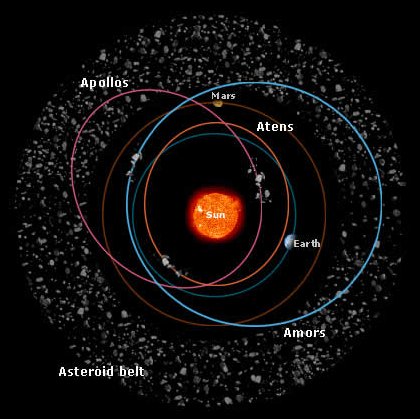
Figure 1. Typical orbits of Apollo-, Amor-, and Aten-type asteroids. Image credit: ESA.
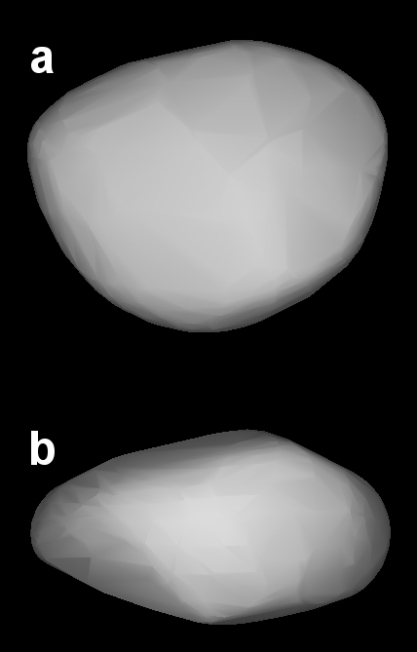
Figure 2. A model of 1862 Apollo viewed from the pole (top) and from the equator (bottom). The irregular shape of asteroids like 1862 Apollo means that photons adsorbed and re-emitted from the surface can produce a net torque that gradually makes the asteroids spin faster – what is known to astronomers as the "YORP" effect. Image credit: Mikko Kaasalainen and Josef Durech.
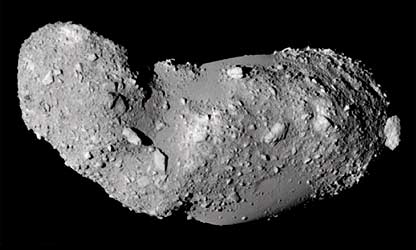
Figure 3. Image of Itokawa taken by Hayabusa from a range of about 20 kilometers.
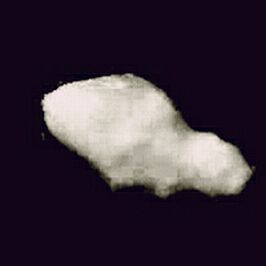
Figure 4. Toutatis.
The Apollo group, also known as Earth-crossing asteroids, is one of three groups of near-Earth asteroids (Figure 1). Apollo group asteroids have semi-major axes greater than 1.0 astronomical units (AU) and perihelia less than 1.017 AU (Earth's aphelion distance).
Some Apollo objects can approach closer than Mercury to the Sun, the record-holder being 1995CR with a perihelion distance of 0.12 AU. Other notable members of the group include 1862 Apollo (the prototype), 1866 Sisyphus (the largest, with a diameter of about 8 kilometers), 3200 Phaethon, 1685 Toro, and 4179 Toutatis.
Adonis
2101 Adonis is a small member of the Apollo group, discovered by Eugene Delaporte in 1936. Adonis was the second Apollo asteroid to be found and may be an extinct comet. In 1937 it came to within 2 million kilometers of Earth, but was then lost until recovered in 1977, by Charles Kowal, following recomputation of its orbit.
| diameter | about 1 km |
| semimajor axis | 1.874 AU |
| perihelion | 0.441 AU |
| aphelion | 3.307 AU |
| inclination | 1.35° |
| period | 2.56 years (936.7 d) |
Apollo
1862 Apollo is the prototype asteroid of the Apollo group (Figure 2). It was discovered by the German astronomer Karl Reinmuth (1892–1979) in 1932, when it approached Earth to within 10.5 million kilometers (0.07 AU), but was then lost until 1973. Apollo can come as close to Earth as 4.2 million kilometers (0.028 AU) and also make near passes of Venus and Mars, whose orbits it crosses at perihelion and aphelion, respectively.
| diameter | 1.4 km |
| spectral class | Q |
| rotational period | 3.063 hours |
| semimajor axis | 1.486 AU |
| perihelion | 0.65 AU |
| aphelion | 2.30 AU |
| eccentricity | 0.57 |
| inclination | 6.4° |
| period | 622 days |
Geographos
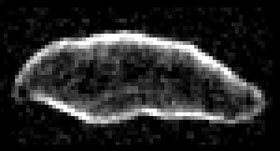 |
Radar image of Geographos from measurements by the Goldstone antenna of the Deep Space Network. Taken on 30 August 1994, at a range of 7,200,000 kilometers. Credit: Steven J. Ostro, NASA/JPL. |
1620 Geographos is an oddly-shaped member of the Apollo group, discovered by Rudolph Minkowski and his American colleague Albert George Wilson (1918–2012) at Palomar Observatory in 1951.
Geographos shows the most extreme variations in its light curve of any object in the Solar System: the amount of light it reflects varies by a factor of 6.5 over the course of an axial rotation. This indicates that Geographos is either very elongated – a cigar-shaped object viewed along a line perpendicular to its spin axis – or is a pair of objects nearly in contact that orbit each other around their center of mass (see binary asteroid. Possibly it acquired its strange form after being splintered off a larger body or by stretching through tidal forces produced during a past close encounter with Earth.
The asteroid's name was chosen to honor the National Geographic Society for its support of the Palomar Observatory Sky Survey.
| diameter | 5.1 × 1.8 km |
| spectral class | S |
| semimajor axis | 1.246 AU |
| perihelion | 0.828 AU |
| aphelion | 1.663 AU |
| inclination | 13.34° |
| period | 1.39 years |
Itokawa
25143 Itokawa is a small asteroid that was the target of the Japanese Hayabusa probe – the first spacecraft to return a sample of material from an asteroid (Figure 3). 25143 Itokawa, also known as 1998 SF36, was discovered by LINEAR in 1998 and is named after the late Hideo Itokawa, considered one of the fathers of Japan's space program. It is both an Apollo asteroid and a Mars-crosser and appears to have an S-type composition.
The first images of Itokawa returned by Hayabusa proved surprising. The asteroid's shape – similar to a knobbly potato – is not what researchers had predicted based on radar images. Another asteroid mission, NASA's NEAR-Shoemaker, visited the asteroid Eros in 2000 and found it to be fairly homogenous. This does not appear to be the case for Itokawa. Early pictures of the asteroid appear to show hilly and rocky regions in addition to some very smooth features. Itokawa's edges appear rounded, possibly the result of eons of being pelted by other space objects. There also appears to be some dust and rocks left over from impacts on the asteroid's surface. This is another surprise because small asteroids, with such a small gravitational pull, were not expected to have much in the way of regolith. It is strongly suspected from its appearance that Itokawa may be a rubble-pile asteroid.
| dimensions | 0.687 × 0.287 × 0.264 km |
| mass | ~4.8 × 1010 kg |
| spectral class | S |
| rotational period | 12.5 hours |
| albedo | 0.53 |
| semimajor axis | 1.324 AU |
| perihelion | 0.953 AU |
| aphelion | 1.695 AU |
| eccentricity | 0.280 |
| inclination | 1.62° |
| orbital period | 556.36 days |
Phaethon
3200 Phaethon is the parent body of the Geminids meteor shower and, since the parent bodies of all other meteor streams identified to date are comets, probably a defunct comet. Discovered by the Infrared Astronomy Satellite in 1983, Phaethon has one of the most extreme orbits of any minor planet, approaching the Sun much closer than Mercury ever does at perihelion and retreating into the main asteroid belt at aphelion. It is a member of the Apollo group.
| diameter | 5 km |
| semimajor axis | 1.271 AU |
| perihelion | 0.140 AU |
| aphelion | 2.403 AU |
| eccentricity | 0.890 |
| inclination | 22.12° |
Toro
1685 Toro is a member of the Apollo group of Earth-crossing asteroids, discovered by Carl Wirtanen in 1948 and rediscovered in 1964, whose closest approach takes it within 0.13 astronomical units (AU) of Earth. Radar observations indicate a rocky surface, thinly covered with dust.
| diameter | 5 × 3 km |
| albedo | 0.15 |
| rotational period | 10.18 hours |
| semimajor axis | 1.37 AU |
| perihelion | 0.77 AU |
| aphelion | 1.96 AU |
| eccentricity | 0.44 |
| period | 584.2 days (8/5 that of Earth) |
Toutatis
4179 Toutatis is one of the largest near-Earth asteroids and potentially one of the most dangerous (see potentially hazardous asteroids (Figure 4). A member of the Apollo group, it was discovered in 1989 by French astronomers and named (somewhat inappropriately) after a Celtic god that was the protector of the tribe in ancient Gaul. Its eccentric, four-year orbit extends from just inside Earth's orbit to the main asteroid belt; the danger comes from the fact that the plane of Toutatis's orbit is closer to the plane of Earth's orbit than any known Earth-crossing asteroid. In December 1992, Toutatis came within about 4 million kilometers of Earth enabling radar images to be acquired using the Goldstone Deep Space Communications Complex in California's Mojave desert. These images revealed two irregularly shaped, cratered objects about 4 and 2.5 kilometers in average diameter which are probably in contact with each other. Such contact binaries may be fairly common since another one, Castalia, was observed in 1989. Numerous surface features on Toutatis, including a pair of large craters, side by side, and a series of three prominent ridges – a type of asteroid mountain range - are presumed to result from a complex history of impacts.
Toutatis shows an extraordinarily complex rotation. Whereas the vast majority of asteroids, and all the planets, spin about a single axis, Toutatis tumbles around two axes with different periods, of 5.4 and 7.3 Earth days, that combine in such a way that Toutatis's orientation with respect to the Solar System never repeats.
On 29 September 2004, Toutatis passed by Earth at a range of just four times the distance between Earth and the Moon. One consequence of the asteroid's frequent close approaches to Earth is that its trajectory more than several centuries from now cannot be predicted accurately. In fact, of all the Earth-crossing asteroids, the orbit of Toutatis is thought to be one of the most chaotic.
| size | 4.5 × 2.4 × 1.9 km |
| density | 2.1 g/cm³ |
| spectral class | S |
| rotational periods | 5.41 and 7.35 days |
| semimajor axis | 2.516 AU |
| perihelion | 0.92 AU |
| aphelion | 4.11 AU |
| inclination | 0.5° |
| period | 4 years |
2004 XP14
2004 XP14 is an Apollo asteroid that passed Earth at the relatively close distance of 432,000 kilometers (269,000 miles) – 1.1 times the Earth-Moon distance – on 3 July 2006 (closest approach at 04:25 UT).
Also classed as a potentially hazardous asteroid, 2004 XP14 is 410 to 920 meters (1,345 to 3,018 feet) across and has an estimated mass of 500 million tons.
2004 XP14 was discovered on 10 December 2004 by the LINEAR asteroid survey.
| eccentricity | 0.157 |
| semi-major axis | 1.057 AU |
| perihelion | 0.891 AU |
| aphelion | 1.224 AU |
| orbital period | 397.11 days |
| inclination | 32.93° |


